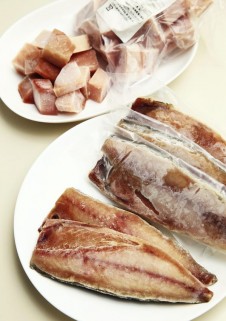Loading
Search
▼ Appetite For ‘Nonstandard’ Foods, Fish Growing
- Category:Other
By Wakako takeuchi / Yomiuri Shimbun Staff Writer
Many vegetables and fish are labeled unfit for sale because of their irregular sizes or imperfections. These products were generally discarded until recently, when a movement to make use of them took hold. Many so-called nonstandard products have become available for purchase online.
Since fiscal 2010, the Japanese food self-sufficiency rate based on calories has fallen below 40 percent; the fiscal 2014 figure was 39 percent. On the other hand, about 6.4 million tons of edible products are discarded each year, according to an estimate by the Agriculture, Forestry and Fisheries Ministry.
The discarded products include misshapen fresh produce. In order to effectively utilize these products, an increasing number of businesses and organizations are bringing them onto the market.
What is considered nonstandard? According to the National Federation of Agricultural Cooperative Associations (Zen-noh), each production area or prefecture sets the standard for shapes and sizes of vegetables, so any product that does not meet their criteria is considered nonstandard.
In 2009, the Palsystem Consumers’ Co-operative Union, based in Shinjuku Ward, Tokyo, initiated the Mottainai Project (too good to waste project). So far it has commercialized 30 vegetable and fruit products that had traditionally been discarded because they were “too small or too big” or “damaged in a typhoon.”
Apart from fresh produce, such as irregularly sized king oyster mushrooms (150 grams for ¥160), there is also processed food such as “strained vegetables,” which is made from nonstandard vegetables that are heated, strained and frozen.
This project offers products 10 percent to 20 percent cheaper than the regular market products. “Flavors and texture are comparable to standard products. These products are quite popular and sell out almost every time,” said a person in charge of Palsystem’s planning and publicity department.
Recipes provided
Daichi Takuhai (Earth delivery) of Chiba-based Daichi o Mamoru Kai (Association for the protection of Earth) operates the Mottainai Sakana (fish too good to waste) project.
It makes products out of fish that were traditionally discarded because of blemishes or unfamiliarity. Since 2010, the association has brought about 110 products onto the market. Prices are 30 percent to 50 percent cheaper than regular market products.
A diverse selection of products is widely available. One example is the nonstandard frozen oysters (300 grams for ¥671) which are small or chipped oysters that are flash frozen. Deep-fried tuna tail (150 grams for ¥551) are made from fish tails that were removed to confirm quality. Recipes from fishermen are attached to lesser-known fish varieties.
Hiroshi Asanoumi, the fisheries team leader of the company’s production department, said: “As long as you have ideas, you can turn many ingredients into marketable products, even if producers believe they are ‘unfit for sale.’ I will continue to look for such resources and develop products.”
The restaurant industry has also picked up on the movement to utilize nonstandard ingredients.
Tsukiji Mottainai Project Uoharu, which opened in January last year in Chiyoda Ward, Tokyo, is a seafood izakaya serving dishes made mainly from nonstandard or blemished products considered unfit for the general market. A few minutes past 10 a.m., head chef Yoshiaki Otahara heads to Yamaharu, a large intermediate wholesale store in Tokyo’s Tsukiji market.
He purchases a large quantity of unsold seafood products.
Young sardines discolored by intestinal damage are made into spicy mabo-shirako, and damaged hokke (Atka mackerel) are sliced into sashimi. Using these recipes, fish considered unfit for sale are transformed into main dishes.
- January 28, 2016
- Comment (0)
- Trackback(0)


